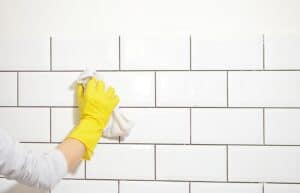An in-depth guide to buying power tools the smart way.

Most handy people develop a pretty big collection of power tools over time.
Whether you’re a passionate DIY-er expanding your skills, a new apprentice getting your first tool allowance, or just someone fixing up your home; you’ll often find yourself needing to buy a power tool or two. And then another power tool. And then another, and another. And so on.
Yet there’s definitely a right and a wrong way to build a power tool collection. By being smart about the way you buy power tools, you can save yourself a lot of time, money and effort in the long run. Here are our best tips for building your power tool collection the smart way.
Choose a brand and stick to it.
Choosing a preferred brand of tools and sticking to it is one of the simplest, best things you can do for yourself in the long run – especially with cordless tools.
For one, it makes accessory shopping and maintenance quite a bit easier. But arguably the biggest benefit is that batteries are generally interchangeable between tools of the same brand.
Some brands do a better job of battery sharing than others. Makita and Ozito both have batteries that are well designed for sharing, but the best performer on this front is probably Bosch. Their 18V ‘Power For All’ battery powers around 40 different Bosch products, and is backwards compatible with any tools made from 2007 onwards.
Battery sharing makes keeping all of your power tools charged and ready-to-go significantly quicker and easier, especially if you buy your tools in a combo pack or purchase a multi-battery charger. Batteries themselves can get pricey too, so being able to reuse your existing batteries for new tools will save you a lot of money as your power tool collection grows.
Don’t forget to consider the battery voltage as well.
You will also have to pay attention to the battery voltages. Obviously, an 18v battery should not go in a 24v power tool, even if they’re the same brand. In many cases, it may actually turn on and work, but it will always affect performance significantly and likely damage your tool’s lifespan over time.
Some jobs might occasionally require you to invest in a tool that’s more powerful and thus has a higher voltage. Generally, though, it’s best to try and stick to one voltage across your tool collection, making battery sharing even easier.
If you still want to try out different brands but you love the convenience of battery sharing, you can use corded tool purchases as an excuse to branch out. This brings us to our next big tip: don’t assume cordless is always the best way to go.
Corded vs. Cordless tools – there’s more to it than you think.
Cordless tools are everywhere these days, and it’s easy to see why.
It’s convenient to not have to worry about the closest power outlet. The hazard of tripping on a wire is eliminated. In many cases they’re smaller, which allows you to reach tighter areas. This makes cordless a perfect fit for essential, everyday DIY tools like the drill.
Yet wired tools have plenty of benefits too. In most cases, wired tools will deliver more torque, which means more power. They can run all day long without going flat, and you’re often getting a better-quality tool compared to the more compact wireless version.
There are a handful of heavy-duty tools where you’re almost always better off getting the higher-powered corded version. Reciprocated saws, table saws, hammer drills and grinders are all power-hungry tools that need a lot of torque. The cordless versions of these tools may not perform as well, and the batteries will die fast.
Generally, the best way to choose between corded or cordless tools is to be realistic about what you need them for. If you’re a DIY-er who only uses your tools occasionally, the convenience of cordless will probably suit you better.
You need to be honest with yourself about your power tool needs.
Honestly, this is something you should be repeating to yourself over and over when you’re browsing all the shiny, expensive toys at the hardware store: Do I need this? Do I need this?
It might be tempting to always fork out for the upmarket model with all the bells and whistles, but do you really need that for the job you’re doing? The fact is, a professional-level power tool with too much power and too many extras can just get in the way if you’re only doing general DIY work on the weekends.
Be realistic. If you just need to saw some thin plywood, don’t buy a huge, heavy-duty table saw. For replacing the hinges on the screen door, just buy that cordless drill. We’re definitely not saying you should choose cheap and nasty tools, but you will be fine with a standard model for most household jobs. In fact, you’ll probably have an easier time.
Tradies buy the serious stuff because they use it everyday, from morning to night, on a wide range of jobs. As a DIYer, you only really need to invest in top-shelf power tools if you notice that you’re actually using your tools all the time. It’s also worth investing more in power tools if you’re setting out on a big & ambitious project, like building your own house.
Never buy generic-brand accessories or consumables.
This is another really common mistake people make with their power tools. DIY-ers are generally practically-minded, so they’ll often baulk at paying a higher price for a brand-name accessory. After all, doesn’t the cheaper generic version just do the same thing, for less?
Most of the time, this turns out to be a bad decision. Branded accessories and disposables have been specially made and tested for the tools, so they’ll perform well and fit the tool. This is not true of generic tool accessories, which are of varying quality and have a good chance of damaging your tool over time if they don’t fit properly.
This may seem too simple a tip, but trust us. Generic brand accessories and disposables aren’t as good for your tools, and you’ll likely spend more money in the long run fixing or replacing your damaged power tools! The cheaper upfront cost of generics is not worth it.
Talk to people, read reviews, and watch what professionals buy.
There’s so much choice in the world today that deciding on a trusted brand can be a bit overwhelming. Doing a bit of general research and getting recommendations from your friends will make deciding much less daunting.
Online reviews are good for quickly learning what experience others had with the tool, but always pay attention to who is leaving the review. That power tool might have earnt one star for being useless and frustrating to an old pro on a construction site, but it might still suit your needs perfectly as a beginner.
Still, reading reviews can be a lifesaver when it comes to avoiding nasty, low-quality power tools, especially at the budget price level. If the price seems too good to be true, it usually is! We always recommend talking to your friends and colleagues about what they buy as well. You’ll usually get some solid info that’s less confusing than a jumble of short, conflicting reviews.
Finally, if you’re looking to invest in a quality power tool, pay attention to what the tradies are using. Their needs are the heaviest, and if you’re seeing the same power tool brand on construction site after construction site then it’s likely something you can trust to get the job done.
Building a collection of power tools as a DIY-er doesn’t have to be a daunting experience. Following these 6 tips will help you do a much better job of it. By making smart decisions from the beginning, you can save a lot of time, effort and money overall.
Not keen on braving the hardware store crowds? Browse our curated online range of power tools and power tool accessories at Multifors. We offer delivery across Metro Melbourne for only $19.95, so that you can get started on the job right away with no extra effort.
-
 11, Jul, 2022
11, Jul, 2022Feature Product: The Stain Proof Range
We regularly review some of our favourite products. Today, we’re... -
 5, Jul, 2022
5, Jul, 2022Concrete Sealer: What You Need to Know
Concrete is a sturdy material that’s practical and affordable. In... -
 24, Jun, 2022
24, Jun, 2022A Product Guide for DIY Pool Areas
Tiling a pool area is a great DIY project. In...


